Assessment of Carbon Stock and Sequestration Dynamics in Response to Land Use and Land Cover Changes in a Tropical Landscape
Abstract
:1. Introduction
2. Materials and Methods
2.1. Descriptions of the Study Area
2.2. Generation of LULC Map for 2006, 2014 and 2021
2.2.1. Satellite Data
2.2.2. Satellite-Based Predictor Variables
2.2.3. LULC Categories and Reference Data
2.2.4. LULC Classification and Accuracy Assessment
2.3. LULC Prediction for the Year 2030 Using LCM
2.3.1. Change Analysis
2.3.2. Transition Potentials
2.3.3. Change Prediction
2.3.4. Model Validation
2.4. Estimation of Carbon Stock and Sequestration Using ESM
2.4.1. LULC Images
2.4.2. Carbon Pools Table
2.4.3. Economic Valuation
3. Results
3.1. LULC Types and Accuracy
3.2. LULC Change and Prediction
3.3. Carbon Stock and Sequestration with Economic Valuation
4. Discussions
5. Conclusions
Supplementary Materials
Author Contributions
Funding
Data Availability Statement
Acknowledgments
Conflicts of Interest
References
- Ravindranath, N.H.; Ostwald, M. Carbon Inventory Methods: Handbook for Greenhouse Gas Inventory, Carbon Mitigation and Roundwood Production Projects; Springer: Dordrecht, The Netherlands, 2008; ISBN 978-1-4020-6546-0. [Google Scholar]
- IPCC. Climate Change 2021: The Physical Science Basis. Contribution of Working Group I to the Sixth Assessment Report of the Intergovernmental Panel on Climate Change; Masson-Delmotte, V., Zhai, P., Pirani, A., Connors, S.L., Péan, C., Berger, S., Caud, N., Chen, Y., Goldfarb, L., Gomis, M.I., et al., Eds.; Cambridge University Press: Cambridge, UK, 2021. [Google Scholar]
- IPCC. Climate Change 2007: The Physical Science Basis. Contribution of Working Group I to the Fourth Assessment Report of the Intergovernmental Panel on Climate Change; Solomon, S., Qin, D., Manning, M., Chen, Z., Marquis, M., Averyt, K.B., Tignor, M., Miller, H.L., Eds.; Cambridge University Press: Cambridge, UK, 2007. [Google Scholar]
- Babbar, D.; Areendran, G.; Sahana, M.; Sarma, K.; Raj, K.; Sivadas, A. Assessment and Prediction of Carbon Sequestration Using Markov Chain and InVEST Model in Sariska Tiger Reserve, India. J. Clean. Prod. 2021, 278, 123333. [Google Scholar] [CrossRef]
- Zhang, J.; Ge, Y.; Chang, J.; Jiang, B.; Jiang, H.; Peng, C.; Zhu, J.; Yuan, W.; Qi, L.; Yu, S. Carbon Storage by Ecological Service Forests in Zhejiang Province, Subtropical China. For. Ecol. Manag. 2007, 245, 64–75. [Google Scholar] [CrossRef]
- Zhang, F.; Zhan, J.; Zhang, Q.; Yao, L.; Liu, W. Impacts of Land Use/Cover Change on Terrestrial Carbon Stocks in Uganda. Phys. Chem. Earth Parts A/B/C 2017, 101, 195–203. [Google Scholar] [CrossRef]
- García, M.; Riaño, D.; Chuvieco, E.; Danson, F.M. Estimating Biomass Carbon Stocks for a Mediterranean Forest in Central Spain Using LiDAR Height and Intensity Data. Remote Sens. Environ. 2010, 114, 816–830. [Google Scholar] [CrossRef]
- Dixon, R.K.; Solomon, A.M.; Brown, S.; Houghton, R.A.; Trexier, M.C.; Wisniewski, J. Carbon Pools and Flux of Global Forest Ecosystems. Science 1994, 263, 185–190. [Google Scholar] [CrossRef]
- Agboola, O.O.; Mayowa, F.; Adeonipekun, P.A.; Akintuyi, A.; Gbenga, O.; Ogundipe, O.T.; Omojola, A.; Alabi, S. A Rapid Exploratory Assessment of Vegetation Structure and Carbon Pools of the Remaining Tropical Lowland Forests of Southwestern Nigeria. Trees For. People 2021, 6, 100158. [Google Scholar] [CrossRef]
- Behera, S.K.; Sahu, N.; Mishra, A.K.; Bargali, S.S.; Behera, M.D.; Tuli, R. Aboveground Biomass and Carbon Stock Assessment in Indian Tropical Deciduous Forest and Relationship with Stand Structural Attributes. Ecol. Eng. 2017, 99, 513–524. [Google Scholar] [CrossRef]
- Xu, L.; Saatchi, S.S.; Shapiro, A.; Meyer, V.; Ferraz, A.; Yang, Y.; Bastin, J.-F.; Banks, N.; Boeckx, P.; Verbeeck, H.; et al. Spatial Distribution of Carbon Stored in Forests of the Democratic Republic of Congo. Sci. Rep. 2017, 7, 15030. [Google Scholar] [CrossRef]
- Chazdon, R.L.; Broadbent, E.N.; Rozendaal, D.M.A.; Bongers, F.; Zambrano, A.M.A.; Aide, T.M.; Balvanera, P.; Becknell, J.M.; Boukili, V.; Brancalion, P.H.S.; et al. Carbon Sequestration Potential of Second-Growth Forest Regeneration in the Latin American Tropics. Sci. Adv. 2016, 2, e1501639. [Google Scholar] [CrossRef]
- Meister, K.; Ashton, M.S.; Craven, D.; Griscom, H. Carbon Dynamics of Tropical Forests. In Managing Forest Carbon in a Changing Climate; Ashton, M.S., Tyrrell, M.L., Spalding, D., Gentry, B., Eds.; Springer: Dordrecht, The Netherlands, 2012; pp. 51–75. ISBN 978-94-007-2232-3. [Google Scholar]
- Gaston, G.; Brown, S.; Lorenzini, M.; Singh, K.D. State and Change in Carbon Pools in the Forests of Tropical Africa. Glob. Change Biol. 1998, 4, 97–114. [Google Scholar] [CrossRef]
- Hosonuma, N.; Herold, M.; De Sy, V.; De Fries, R.S.; Brockhaus, M.; Verchot, L.; Angelsen, A.; Romijn, E. An Assessment of Deforestation and Forest Degradation Drivers in Developing Countries. Environ. Res. Lett. 2012, 7, 044009. [Google Scholar] [CrossRef]
- Houghton, R.A. Carbon Emissions and the Drivers of Deforestation and Forest Degradation in the Tropics. Curr. Opin. Environ. Sustain. 2012, 4, 597–603. [Google Scholar] [CrossRef]
- Kanninen, M. (Ed.) Do Trees Grow on Money? The Implications of Deforestation Research for Policies to Promote REDD; Forest perspectives; Center for International Forestry Research: Situ Gede, Bogor, Indonesia, 2007; ISBN 978-979-1412-42-1. [Google Scholar]
- Geist, H.J.; Lambin, E.F. Proximate Causes and Underlying Driving Forces of Tropical Deforestation. BioScience 2002, 52, 143. [Google Scholar] [CrossRef]
- Liu, Q.; Yang, D.; Cao, L.; Anderson, B. Assessment and Prediction of Carbon Storage Based on Land Use/Land Cover Dynamics in the Tropics: A Case Study of Hainan Island, China. Land 2022, 11, 244. [Google Scholar] [CrossRef]
- Liang, Y.; Hashimoto, S.; Liu, L. Integrated Assessment of Land-Use/Land-Cover Dynamics on Carbon Storage Services in the Loess Plateau of China from 1995 to 2050. Ecol. Indic. 2021, 120, 106939. [Google Scholar] [CrossRef]
- Gratani, L.; Varone, L.; Bonito, A. Carbon Sequestration of Four Urban Parks in Rome. Urban For. Urban Green. 2016, 19, 184–193. [Google Scholar] [CrossRef]
- Areendran, G.; Sahana, M.; Raj, K.; Kumar, R.; Sivadas, A.; Kumar, A.; Deb, S.; Gupta, V.D. A Systematic Review on High Conservation Value Assessment (HCVs): Challenges and Framework for Future Research on Conservation Strategy. Sci. Total Environ. 2020, 709, 135425. [Google Scholar] [CrossRef]
- Dinda, S.; Ghosh, S.; Chatterjee, N.D. Understanding the Commercialization Patterns of Non-Timber Forest Products and Their Contribution to the Enhancement of Tribal Livelihoods: An Empirical Study from Paschim Medinipur District, India. Small-Scale For. 2020, 19, 371–397. [Google Scholar] [CrossRef]
- Bera, D.; Chatterjee, N.D.; Ghosh, S.; Dinda, S.; Bera, S.; Mandal, M. Assessment of Forest Cover Loss and Impacts on Ecosystem Services: Coupling of Remote Sensing Data and Public’s Perception in the Dry Deciduous Forest of West Bengal, India. J. Clean. Prod. 2022, 356, 131763. [Google Scholar] [CrossRef]
- Bera, D.; Das Chatterjee, N.; Bera, S.; Rana, A.; Paul, B. Determining Recent Trends of Forest Loss and Its Associated Drivers for Sustainable Management in the Dry Deciduous Forest of West Bengal, India. In Environmental Management and Sustainability in India: Case Studies from West Bengal; Sahu, A.S., Das Chatterjee, N., Eds.; Springer International Publishing: Cham, Switzerland, 2023; pp. 171–186. ISBN 978-3-031-31399-8. [Google Scholar]
- Bera, D.; Das Chatterjee, N.; Bera, S.; Ghosh, S.; Dinda, S. Comparative Performance of Sentinel-2 MSI and Landsat-8 OLI Data in Canopy Cover Prediction Using Random Forest Model: Comparing Model Performance and Tuning Parameters. Adv. Space Res. 2023, 71, 4691–4709. [Google Scholar] [CrossRef]
- West Bengal Forest Department, Government of West Bengal, India. Annual Administrative Report 2021–2022; West Bengal Forest Department, Government of West Bengal: Kolkata, India, 2022.
- NASA JPL NASA Shuttle Radar Topography Mission Global 1 Arc Second 2013. Available online: https://lpdaac.usgs.gov/products/srtmgl1v003/ (accessed on 21 March 2023).
- Farr, T.G.; Rosen, P.A.; Caro, E.; Crippen, R.; Duren, R.; Hensley, S.; Kobrick, M.; Paller, M.; Rodriguez, E.; Roth, L.; et al. The Shuttle Radar Topography Mission. Rev. Geophys. 2007, 45, RG2004. [Google Scholar] [CrossRef]
- Baugh, K.; Elvidge, C.D.; Ghosh, T.; Ziskin, D. Development of a 2009 Stable Lights Product Using DMSP-OLS Data. Proc. Asia-Pac. Adv. Netw. 2010, 30, 114. [Google Scholar] [CrossRef]
- Elvidge, C.D.; Ziskin, D.; Baugh, K.E.; Tuttle, B.T.; Ghosh, T.; Pack, D.W.; Erwin, E.H.; Zhizhin, M. A Fifteen Year Record of Global Natural Gas Flaring Derived from Satellite Data. Energies 2009, 2, 595–622. [Google Scholar] [CrossRef]
- Elvidge, C.D.; Baugh, K.; Zhizhin, M.; Hsu, F.C.; Ghosh, T. VIIRS Night-Time Lights. Int. J. Remote Sens. 2017, 38, 5860–5879. [Google Scholar] [CrossRef]
- Gorelick, N.; Hancher, M.; Dixon, M.; Ilyushchenko, S.; Thau, D.; Moore, R. Google Earth Engine: Planetary-Scale Geospatial Analysis for Everyone. Remote Sens. Environ. 2017, 202, 18–27. [Google Scholar] [CrossRef]
- Urbazaev, M. Assessment of the Mapping of Fractional Woody Cover in Southern African Savannas Using Multi-Temporal and Polarimetric ALOS PALSAR L-Band Images. Remote Sens. Environ. 2015, 166, 138–153. [Google Scholar] [CrossRef]
- Rouse, J.W.; Haas, R.H.; Schell, J.A.; Deering, D.W.; Harlan, J.C. Monitoring the Vernal Advancement and Retrogradation (Green Wave Effect) of Natural Vegetation. In NASA/GSFC Type III Final Report; NASA/GSFC: Greenbelt, MD, USA, 1974; Volume 371. [Google Scholar]
- Zha, Y.; Gao, J.; Ni, S. Use of Normalized Difference Built-up Index in Automatically Mapping Urban Areas from TM Imagery. Int. J. Remote Sens. 2003, 24, 583–594. [Google Scholar] [CrossRef]
- Xu, H. Modification of Normalised Difference Water Index (NDWI) to Enhance Open Water Features in Remotely Sensed Imagery. Int. J. Remote Sens. 2006, 27, 3025–3033. [Google Scholar] [CrossRef]
- Rikimaru, A.; Roy, P.S.; Miyatake, S. Tropical Forest Cover Density Mapping. Trop. Ecol. 2002, 43, 39–47. [Google Scholar]
- Margono, B.A.; Bwangoy, J.-R.B.; Potapov, P.V.; Hansen, M.C. Mapping Wetlands in Indonesia Using Landsat and PALSAR Data-Sets and Derived Topographical Indices. Geo-Spat. Inf. Sci. 2014, 17, 60–71. [Google Scholar] [CrossRef]
- Jones, J.W. Efficient Wetland Surface Water Detection and Monitoring via Landsat: Comparison with in Situ Data from the Everglades Depth Estimation Network. Remote Sens. 2015, 7, 12503–12538. [Google Scholar] [CrossRef]
- Shi, K.; Huang, C.; Yu, B.; Yin, B.; Huang, Y.; Wu, J. Evaluation of NPP-VIIRS Night-Time Light Composite Data for Extracting Built-up Urban Areas. Remote Sens. Lett. 2014, 5, 358–366. [Google Scholar] [CrossRef]
- Mncube, Z.; Xulu, S. Progress of Nighttime Light Applications within the Google Earth Engine Cloud Platform. Geocarto Int. 2022, 38, 1–22. [Google Scholar] [CrossRef]
- Breiman, L. Random Forests. Mach. Learn. 2001, 45, 5–32. [Google Scholar] [CrossRef]
- Torre-Tojal, L.; Bastarrika, A.; Boyano, A.; Lopez-Guede, J.M.; Graña, M. Above-Ground Biomass Estimation from LiDAR Data Using Random Forest Algorithms. J. Comput. Sci. 2022, 58, 101517. [Google Scholar] [CrossRef]
- Chan, J.C.-W.; Paelinckx, D. Evaluation of Random Forest and Adaboost Tree-Based Ensemble Classification and Spectral Band Selection for Ecotope Mapping Using Airborne Hyperspectral Imagery. Remote Sens. Environ. 2008, 112, 2999–3011. [Google Scholar] [CrossRef]
- Freeman, E.A.; Moisen, G.G.; Coulston, J.W.; Wilson, B.T. Random Forests and Stochastic Gradient Boosting for Predicting Tree Canopy Cover: Comparing Tuning Processes and Model Performance. Can. J. For. Res. 2016, 46, 323–339. [Google Scholar] [CrossRef]
- Moreno Muñoz, A.S.; Guzmán Alvis, Á.I.; Benavides Martínez, I.F. A Random Forest Model to Predict Soil Organic Carbon Storage in Mangroves from Southern Colombian Pacific Coast. Estuar. Coast. Shelf Sci. 2024, 299, 108674. [Google Scholar] [CrossRef]
- Zhang, L.; Huettmann, F.; Zhang, X.; Liu, S.; Sun, P.; Yu, Z.; Mi, C. The Use of Classification and Regression Algorithms Using the Random Forests Method with Presence-Only Data to Model Species’ Distribution. MethodsX 2019, 6, 2281–2292. [Google Scholar] [CrossRef]
- Tikuye, B.G.; Rusnak, M.; Manjunatha, B.R.; Jose, J. Land Use and Land Cover Change Detection Using the Random Forest Approach: The Case of The Upper Blue Nile River Basin, Ethiopia. Glob. Chall. 2023, 7, 2300155. [Google Scholar] [CrossRef]
- Liaw, A.; Wiener, M. Classification and Regression by randomForest. R News 2002, 2, 5. [Google Scholar]
- Evans, J.S.; Cushman, S.A. Gradient Modeling of Conifer Species Using Random Forests. Landsc. Ecol 2009, 24, 673–683. [Google Scholar] [CrossRef]
- Congalton, R.G.; Green, K. Assessing the Accuracy of Remotely Sensed Data: Principles and Practices, 3rd ed.; CRC Press: Boca Raton, FL, USA, 2019; ISBN 978-0-429-62935-8. [Google Scholar]
- Bera, D.; Das Chatterjee, N.; Mumtaz, F.; Dinda, S.; Ghosh, S.; Zhao, N.; Bera, S.; Tariq, A. Integrated Influencing Mechanism of Potential Drivers on Seasonal Variability of LST in Kolkata Municipal Corporation, India. Land 2022, 11, 1461. [Google Scholar] [CrossRef]
- Adhikari, S.; Southworth, J. Simulating Forest Cover Changes of Bannerghatta National Park Based on a CA-Markov Model: A Remote Sensing Approach. Remote Sens. 2012, 4, 3215–3243. [Google Scholar] [CrossRef]
- Eastman, J.R. TerrSet Geospatial Monitoring and Modeling System; Clark University: Worcester, MA, USA, 2016; pp. 345–389. [Google Scholar]
- Singh, V.G.; Singh, S.K.; Kumar, N.; Singh, R.P. Simulation of Land Use/Land Cover Change at a Basin Scale Using Satellite Data and Markov Chain Model. Geocarto Int. 2022, 37, 11339–11364. [Google Scholar] [CrossRef]
- Jain, R.K.; Jain, K.; Ali, S.R. Modeling Urban Land Cover Growth Dynamics Based on Land Change Modeler (LCM) Using Remote Sensing: A Case Study of Gurgaon, India. Adv. Comput. Sci. Technol. 2017, 10, 2947–2961. [Google Scholar]
- Eastman, J.R. IDRISI Selva Manual; Clark labs-Clark University: Worcester, MA, USA, 2012. [Google Scholar]
- Munsi, M.; Areendran, G.; Joshi, P.K. Modeling Spatio-Temporal Change Patterns of Forest Cover: A Case Study from the Himalayan Foothills (India). Reg Env. Chang. 2012, 12, 619–632. [Google Scholar] [CrossRef]
- Eastman, J.R.; Van Fossen, M.E.; Solarzano, L.A. Transition Potential Modeling for Land Cover Change. GIS Spat. Anal. Model. 2005, 17, 357–386. [Google Scholar]
- Anand, J.; Gosain, A.K.; Khosa, R. Prediction of Land Use Changes Based on Land Change Modeler and Attribution of Changes in the Water Balance of Ganga Basin to Land Use Change Using the SWAT Model. Sci. Total Environ. 2018, 644, 503–519. [Google Scholar] [CrossRef]
- Pontius, R.G. Quantification Error versus Location Error in Comparison of Categorical Maps. Photogramm. Eng. Remote Sens. 2000, 66, 1011–1016. [Google Scholar]
- Eggleston, H.S.; Buendia, L.; Miwa, K.; Ngara, T.; Tanabe, K. 2006 IPCC Guidelines for National Greenhouse Gas Inventories; IGES: Hayama, Japan, 2006. [Google Scholar]
- Rennert, K.; Errickson, F.; Prest, B.C.; Rennels, L.; Newell, R.G.; Pizer, W.; Kingdon, C.; Wingenroth, J.; Cooke, R.; Parthum, B.; et al. Comprehensive Evidence Implies a Higher Social Cost of CO2. Nature 2022, 610, 687–692. [Google Scholar] [CrossRef] [PubMed]
- Pan, Y.; Birdsey, R.A.; Phillips, O.L.; Houghton, R.A.; Fang, J.; Kauppi, P.E.; Keith, H.; Kurz, W.A.; Ito, A.; Lewis, S.L.; et al. The Enduring World Forest Carbon Sink. Nature 2024, 631, 563–569. [Google Scholar] [CrossRef] [PubMed]
- Poorter, L.; van der Sande, M.T.; Thompson, J.; Arets, E.J.M.M.; Alarcón, A.; Álvarez-Sánchez, J.; Ascarrunz, N.; Balvanera, P.; Barajas-Guzmán, G.; Boit, A.; et al. Diversity Enhances Carbon Storage in Tropical Forests. Glob. Ecol. Biogeogr. 2015, 24, 1314–1328. [Google Scholar] [CrossRef]
- Pan, Y.; Birdsey, R.A.; Fang, J.; Houghton, R.; Kauppi, P.E.; Kurz, W.A.; Phillips, O.L.; Shvidenko, A.; Lewis, S.L.; Canadell, J.G.; et al. A Large and Persistent Carbon Sink in the World’s Forests. Science 2011, 333, 988–993. [Google Scholar] [CrossRef] [PubMed]
- Waring, B.; Neumann, M.; Prentice, I.C.; Adams, M.; Smith, P.; Siegert, M. Forests and Decarbonization—Roles of Natural and Planted Forests. Front. For. Glob. Change 2020, 3, 58. [Google Scholar] [CrossRef]
- Wei, Y.; Li, M.; Chen, H.; Lewis, B.J.; Yu, D.; Zhou, L.; Zhou, W.; Fang, X.; Zhao, W.; Dai, L. Variation in Carbon Storage and Its Distribution by Stand Age and Forest Type in Boreal and Temperate Forests in Northeastern China. PLoS ONE 2013, 8, e72201. [Google Scholar] [CrossRef]
- Alexandrov, G.A. Carbon Stock Growth in a Forest Stand: The Power of Age. Carbon Balance Manag. 2007, 2, 4. [Google Scholar] [CrossRef]
- Sloan, S.; Sayer, J.A. Forest Resources Assessment of 2015 Shows Positive Global Trends but Forest Loss and Degradation Persist in Poor Tropical Countries. For. Ecol. Manag. 2015, 352, 134–145. [Google Scholar] [CrossRef]
- Walters, B.B. Do Property Rights Matter for Conservation? Family Land, Forests and Trees in Saint Lucia, West Indies. Hum. Ecol. 2012, 40, 863–878. [Google Scholar] [CrossRef]
- Dolisca, F.; McDaniel, J.M.; Teeter, L.D.; Jolly, C.M. Land Tenure, Population Pressure, and Deforestation in Haiti: The Case of Forêt Des Pins Reserve. JFE 2007, 13, 277–289. [Google Scholar] [CrossRef]
- Saraiva, M.B.; Ferreira, M.D.P.; da Cunha, D.A.; Daniel, L.P.; Homma, A.K.O.; Pires, G.F. Forest Regeneration in the Brazilian Amazon: Public Policies and Economic Conditions. J. Clean. Prod. 2020, 269, 122424. [Google Scholar] [CrossRef]
- Tacconi, L.; Rodrigues, R.J.; Maryudi, A. Law Enforcement and Deforestation: Lessons for Indonesia from Brazil. For. Policy Econ. 2019, 108, 101943. [Google Scholar] [CrossRef]
- Williams, B.K. Adaptive Management of Natural Resources—Framework and Issues. J. Environ. Manag. 2011, 92, 1346–1353. [Google Scholar] [CrossRef] [PubMed]
- Lu, S.; Sun, H.; Zhou, Y.; Qin, F.; Guan, X. Examining the Impact of Forestry Policy on Poor and Non-Poor Farmers’ Income and Production Input in Collective Forest Areas in China. J. Clean. Prod. 2020, 276, 123784. [Google Scholar] [CrossRef]
- Pattnaik, B.K.; Dutta, S. JFM in South-West Bengal: A Study in Participatory Development. Econ. Political Wkly. 1997, 32, 3225–3232. [Google Scholar]
- Guha, A.; Pradhan, A.; Mondal, K. Joint Forest Management in West Bengal: A Long Way to Go. J. Hum. Ecol. 2000, 11, 471–476. [Google Scholar] [CrossRef]
- Torralba, M.; Fagerholm, N.; Burgess, P.J.; Moreno, G.; Plieninger, T. Do European Agroforestry Systems Enhance Biodiversity and Ecosystem Services? A Meta-Analysis. Agric. Ecosyst. Environ. 2016, 230, 150–161. [Google Scholar] [CrossRef]
- England, J.R.; Paul, K.I.; Cunningham, S.C.; Madhavan, D.B.; Baker, T.G.; Read, Z.; Wilson, B.R.; Cavagnaro, T.R.; Lewis, T.; Perring, M.P.; et al. Previous Land Use and Climate Influence Differences in Soil Organic Carbon Following Reforestation of Agricultural Land with Mixed-Species Plantings. Agric. Ecosyst. Environ. 2016, 227, 61–72. [Google Scholar] [CrossRef]
- Santos, P.Z.F.; Crouzeilles, R.; Sansevero, J.B.B. Can Agroforestry Systems Enhance Biodiversity and Ecosystem Service Provision in Agricultural Landscapes? A Meta-Analysis for the Brazilian Atlantic Forest. For. Ecol. Manag. 2019, 433, 140–145. [Google Scholar] [CrossRef]
- Pearson, T.R. Measurement Guidelines for the Sequestration of Forest Carbon; US Department of Agriculture, Forest Service, Northern Research Station: Washington, DC, USA, 2007; Volume 18.
- Grussu, G.; Testolin, R.; Saulei, S.; Farcomeni, A.; Yosi, C.K.; De Sanctis, M.; Attorre, F. Optimum Plot and Sample Sizes for Carbon Stock and Biodiversity Estimation in the Lowland Tropical Forests of Papua New Guinea. For. Int. J. For. Res. 2016, 89, 150–158. [Google Scholar] [CrossRef]
- FSI India State of Forest Report 2021. Forest Survey of India. Ministry of Environment & Forest, Dehraduna, India. Available online: https://fsi.nic.in/forest-report-2021-details (accessed on 14 March 2023).
- Baker, T.R.; Phillips, O.L.; Malhi, Y.; Almeida, S.; Arroyo, L.; Di Fiore, A.; Erwin, T.; Killeen, T.J.; Laurance, S.G.; Laurance, W.F.; et al. Variation in Wood Density Determines Spatial Patterns inAmazonian Forest Biomass. Glob. Change Biol. 2004, 10, 545–562. [Google Scholar] [CrossRef]
- Chave, J.; Andalo, C.; Brown, S.; Cairns, M.A.; Chambers, J.Q.; Eamus, D.; Fölster, H.; Fromard, F.; Higuchi, N.; Kira, T.; et al. Tree Allometry and Improved Estimation of Carbon Stocks and Balance in Tropical Forests. Oecologia 2005, 145, 87–99. [Google Scholar] [CrossRef] [PubMed]
- FSI. FSI Volume Equations for Forests of India, Nepal, and Bhutan; Forest Survey of India, Ministry of Environment & Forests: Dehraduna, India, 1996.
- Penman, J.; Gytarsky, M.; Hiraishi, T.; Krug, T.; Kruger, D.; Pipatti, R.; Buendia, L.; Miwa, K.; Ngara, T.; Tanabe, K.; et al. Intergovernmental Panel on Climate Change: Good Practice Guidance for Land Use, Land-Use Change and Forestry; Institute for Global Environmental Strategies: Yamaguchi, Japan, 2003. [Google Scholar]
- Subedi, B.P.; Pandey, S.S.; Pandey, A.; Rana, E.B.; Bhattarai, S.; Banskota, T.R.; Charmakar, S.; Tamrakar, R. Forest Carbon Stock Measurement: Guidelines for Measuring Carbon Stocks in Community-Managed Forests; ANSAB, FECOFUN, ICIMOD: Kathmandu, Nepal, 2010. [Google Scholar]
- Chaturvedi, R.K.; Raghubanshi, A.S.; Singh, J.S. Sapling Harvest: A Predominant Factor Affecting Future Composition of Tropical Dry Forests. For. Ecol. Manag. 2017, 384, 221–235. [Google Scholar] [CrossRef]
- Chaturvedi, R.K.; Raghubanshi, A.S. Aboveground Biomass Estimation of Small Diameter Woody Species of Tropical Dry Forest. New For. 2013, 44, 509–519. [Google Scholar] [CrossRef]
- Schnitzer, S.A.; Bongers, F. The Ecology of Lianas and Their Role in Forests. Trends Ecol. Evol. 2002, 17, 223–230. [Google Scholar] [CrossRef]
- Schnitzer, S.A. A Mechanistic Explanation for Global Patterns of Liana Abundance and Distribution. Am. Nat. 2005, 166, 262–276. [Google Scholar] [CrossRef]
- Chao, K.-J.; Chen, Y.-S.; Song, G.-Z.M.; Chang, Y.-M.; Sheue, C.-R.; Phillips, O.L.; Hsieh, C.-F. Carbon Concentration Declines with Decay Class in Tropical Forest Woody Debris. For. Ecol. Manag. 2017, 391, 75–85. [Google Scholar] [CrossRef]
- Zaninovich, S.C.; Gatti, M.G. Carbon Stock Densities of Semi-Deciduous Atlantic Forest and Pine Plantations in Argentina. Sci. Total Environ. 2020, 747, 141085. [Google Scholar] [CrossRef]
- Harmon, M.E.; Woodall, C.W.; Fasth, B.; Sexton, J.; Yatkov, M. Differences between Standing and Downed Dead Tree Wood Density Reduction Factors: A Comparison across Decay Classes and Tree Species; Research Paper NRS-15; Department of Agriculture, Forest Service, Northern Research Station: Newtown Square, PA, USA, 2011; Volume 15, 40p. [CrossRef]
- Domke, G.M.; Woodall, C.W.; Smith, J.E. Accounting for Density Reduction and Structural Loss in Standing Dead Trees: Implications for Forest Biomass and Carbon Stock Estimates in the United States. Carbon Balance Manag. 2011, 6, 14. [Google Scholar] [CrossRef]
- Chao, K.-J.; Phillips, O.L.; Baker, T.R. Wood Density and Stocks of Coarse Woody Debris in a Northwestern Amazonian Landscape. Can. J. For. Res. 2008, 38, 795–805. [Google Scholar] [CrossRef]
- Takahashi, M. Direct Estimation of Carbon Mass of Organic Layer from Dry Weight. J. For. Res. 2005, 10, 239–241. [Google Scholar] [CrossRef]
- Nelson, D.W.; Sommers, L.E. Total Carbon, Organic Carbon, and Organic Matter. In Methods of Soil Analysis; John Wiley & Sons: Hoboken, NJ, USA, 1983; pp. 539–579. ISBN 978-0-89118-977-0. [Google Scholar]
- Blake, G.R. Bulk Density. In Methods of Soil Analysis; John Wiley & Sons: Hoboken, NJ, USA, 1965; pp. 374–390. ISBN 978-0-89118-203-0. [Google Scholar]
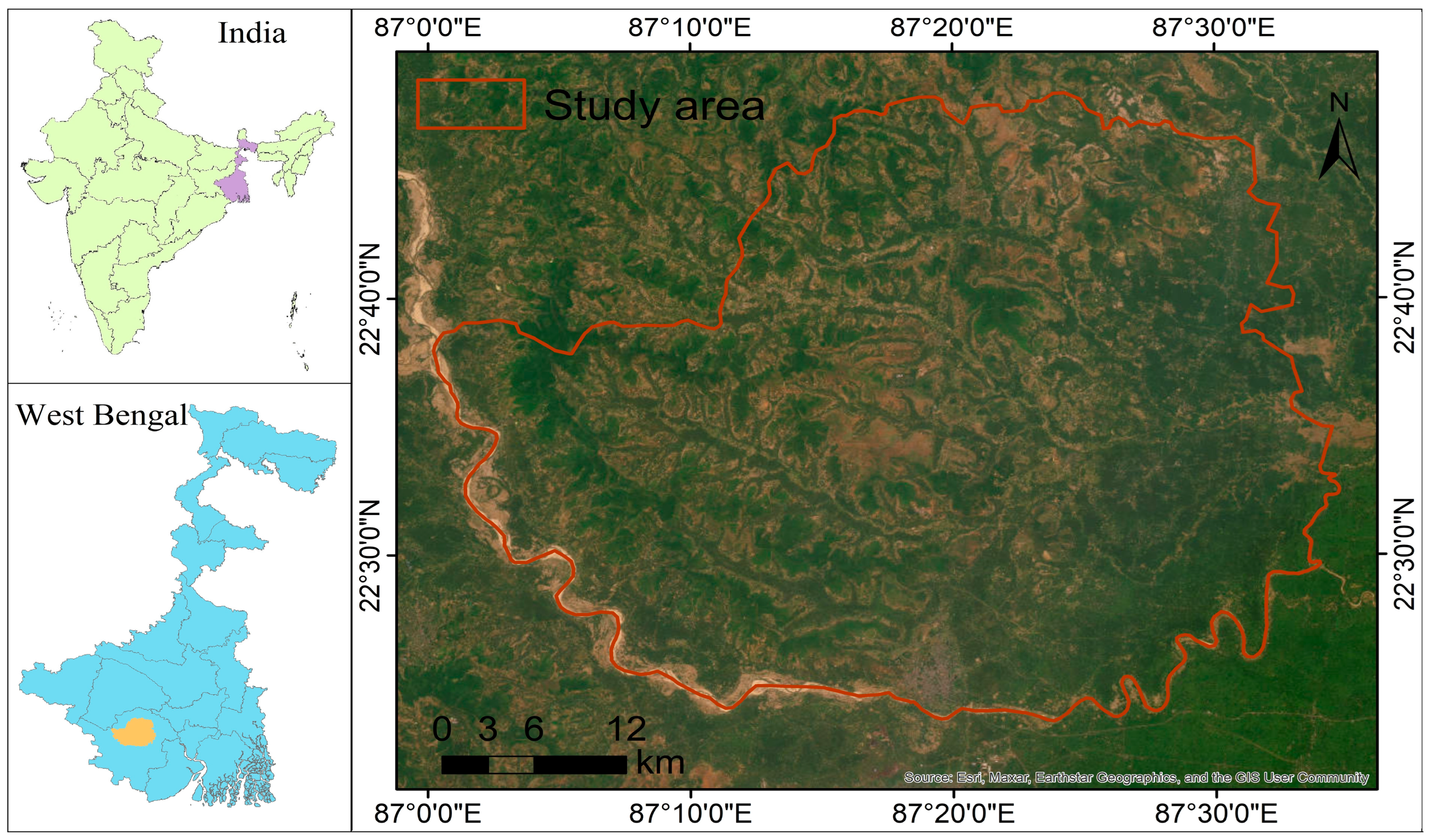

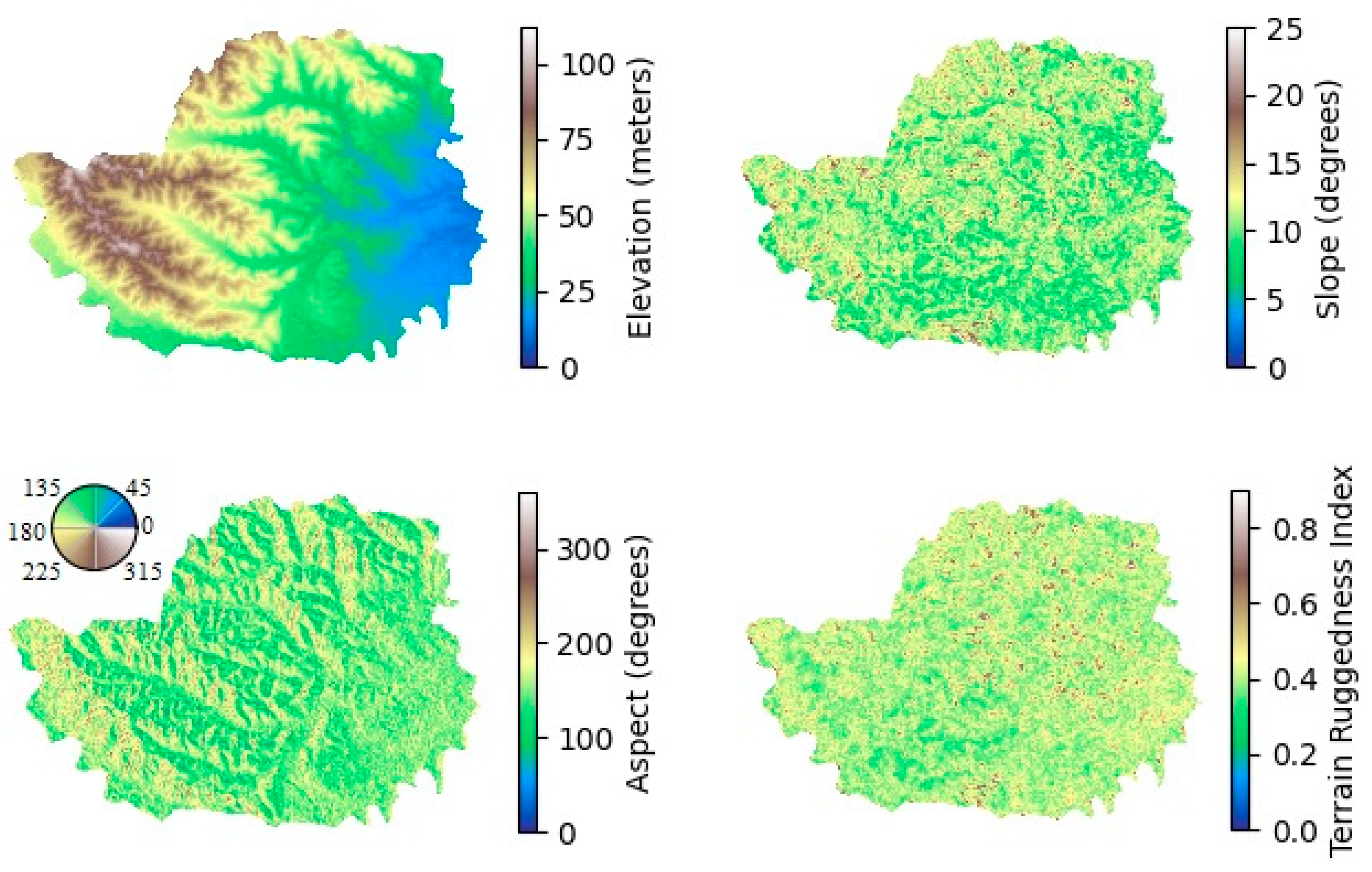
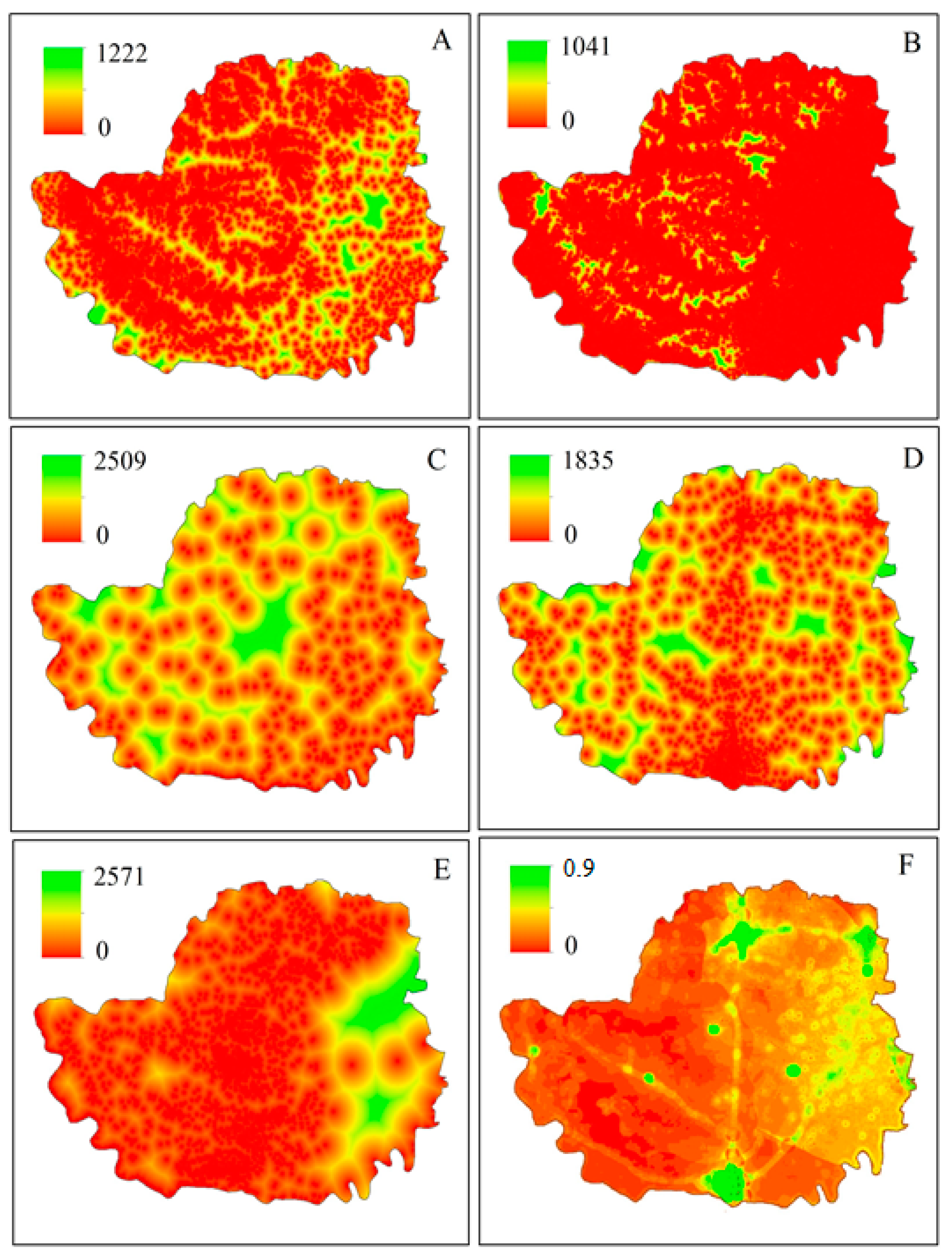

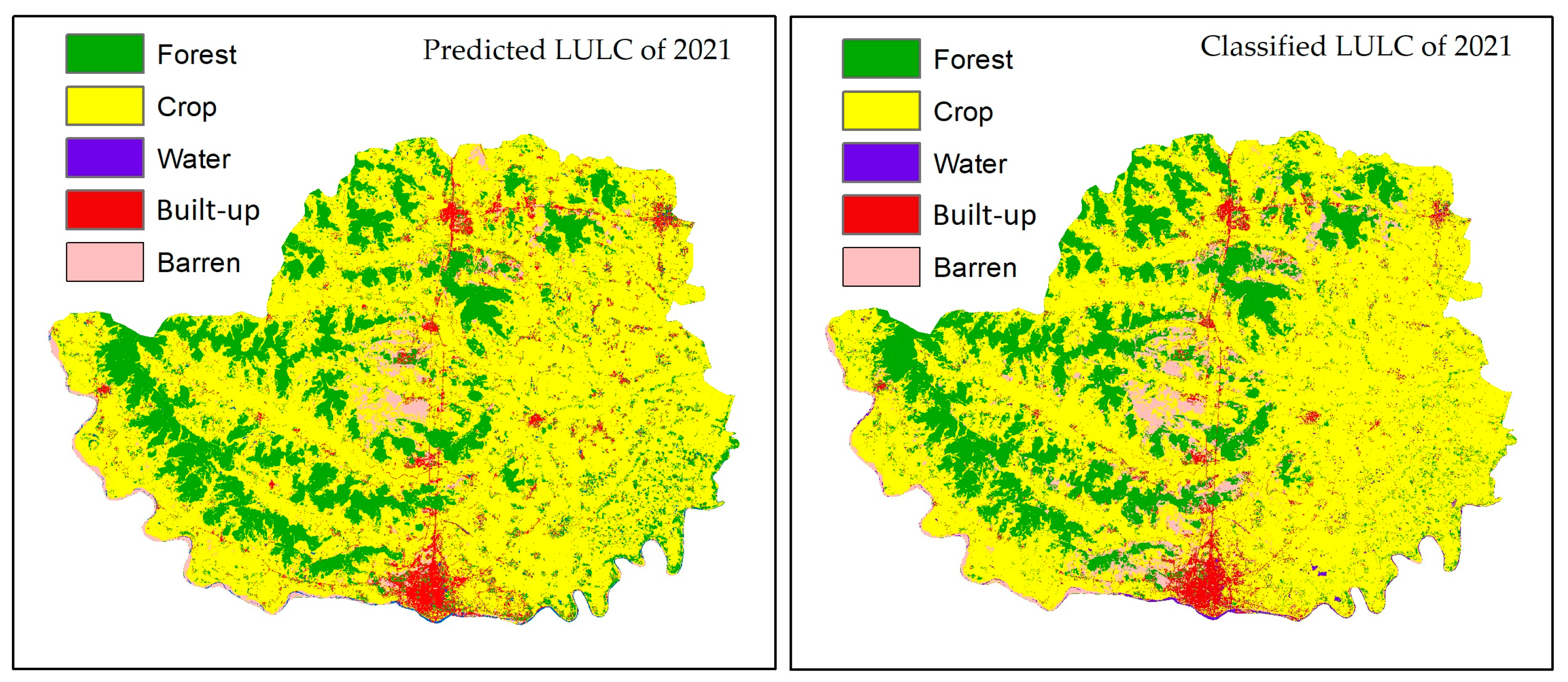
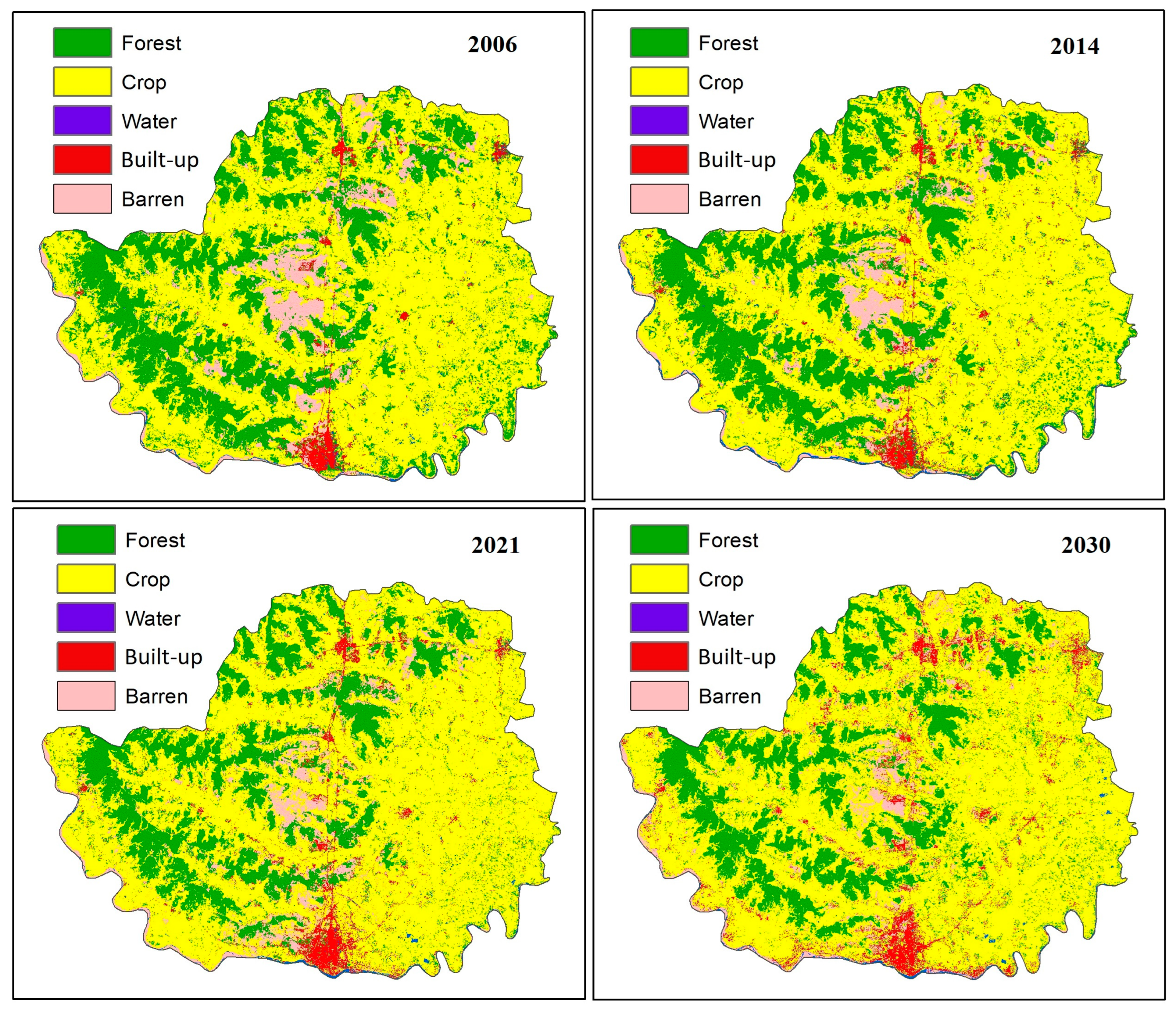
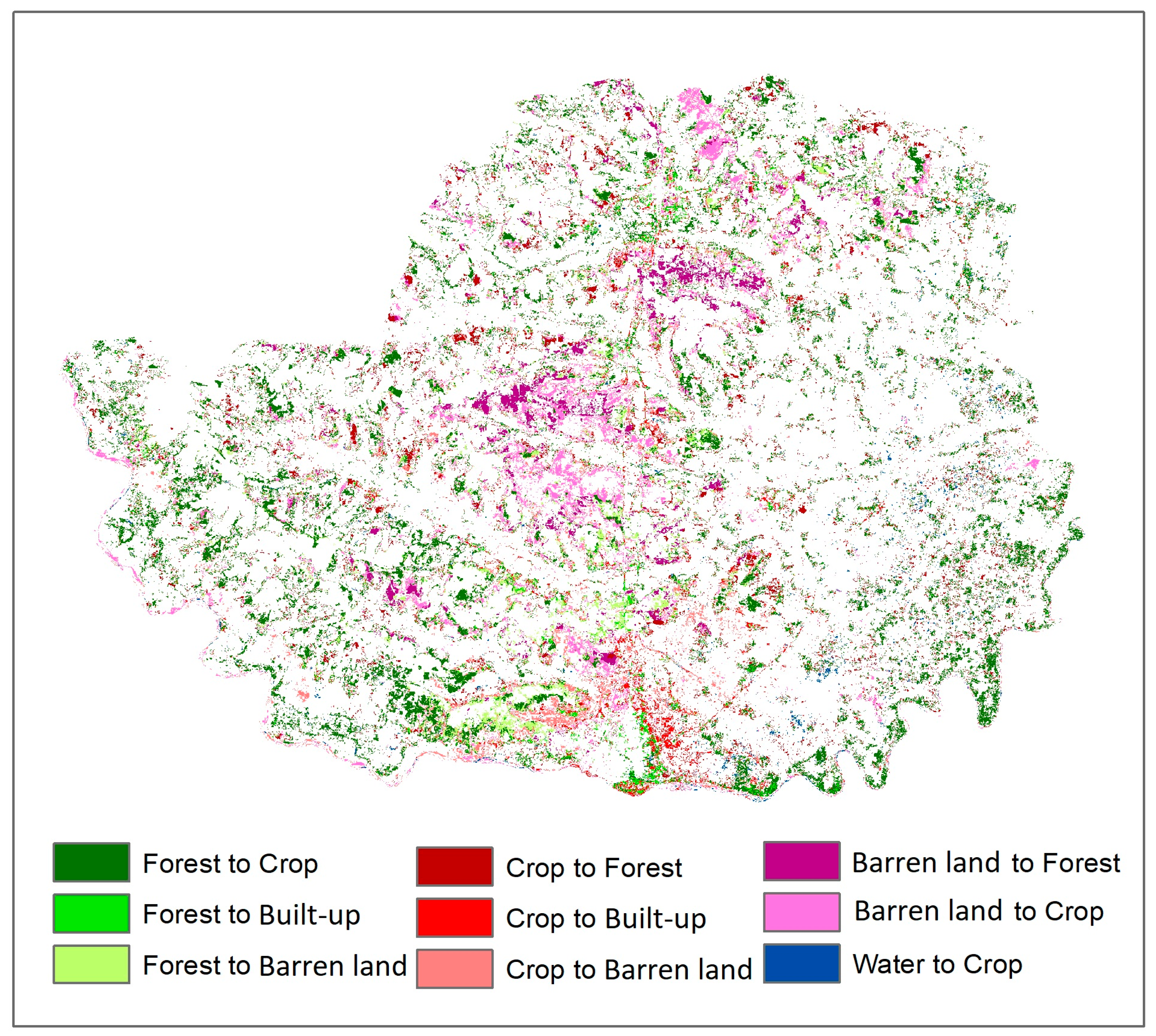
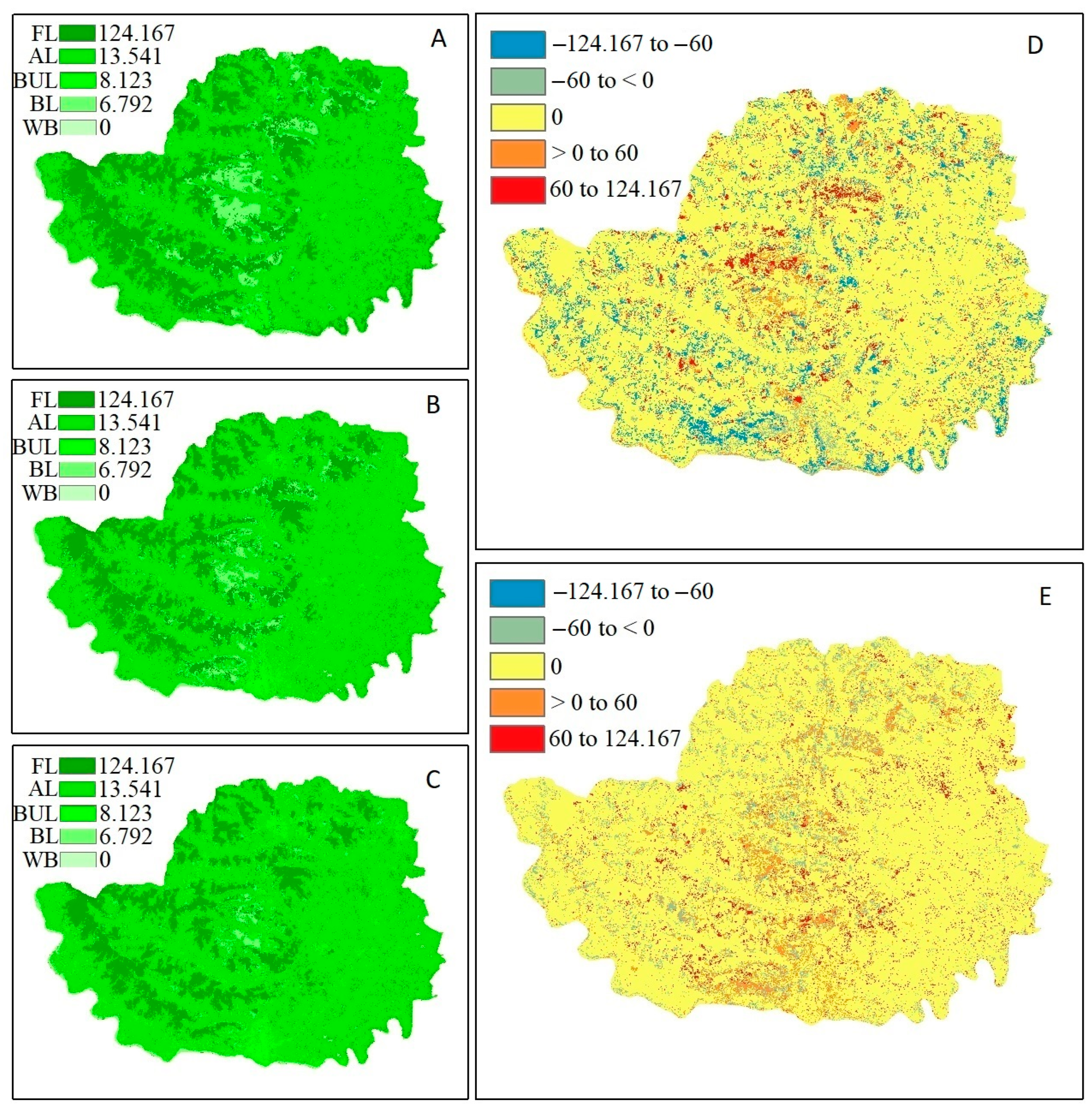
| Product | Data ID | Year | Data Source |
|---|---|---|---|
| Landsat-5 | LANDSAT/LT05/C02/T1_L2 | 2006 | https://www.usgs.gov/landsat-missions, accessed on 22 August 2024 |
| Landsat-8 | LANDSAT/LC08/C02/T1_L2 | 2014, 2021 | https://www.usgs.gov/landsat-missions, accessed on 22 August 2024 |
| SRTM-DEM | USGS/SRTMGL1_003 | 2000 | https://lpdaac.usgs.gov/products/srtmgl1nv003, accessed on 22 August 2024 |
| DMSP-OLS | NOAA/DMSP-OLS/NIGHTTIME_LIGHTS | 2006 | https://eogdata.mines.edu/products/dmsp, accessed on 22 August 2024 |
| VIIRS | NOAA/VIIRS/DNB/MONTHLY_V1/VCMSLCFG | 2014, 2021 | https://eogdata.mines.edu/products/vnl, accessed on 22 August 2024 |
| Landsat-5 | Landsat-8 | ||||
|---|---|---|---|---|---|
| Name | Description | Wavelength (nm) | Name | Description | Wavelength (nm) |
| B1 | Blue (B) | 452–514 | B2 | Blue (B) | 450–515 |
| B2 | Green (G) | 519–601 | B3 | Green (G) | 525–600 |
| B3 | Red (R) | 631–692 | B4 | Red (R) | 630–680 |
| B4 | Near-Infrared (NIR) | 772–898 | B5 | Near-Infrared (NIR) | 845–885 |
| B5 | Short-Wave Infrared 1 (SWIR1) | 1547–1748 | B6 | Short-Wave Infrared 1 (SWIR1) | 1560–1660 |
| B7 | Short-Wave Infrared 2 (SWIR2) | 2065–2345 | B7 | Short-Wave Infrared 2 (SWIR2) | 2100–2300 |
| Data/Product | Variables | Descriptions |
|---|---|---|
| Landsat 5, 8 | Blue | Spectral bands; for details see Table 2 |
| Green | ||
| Red | ||
| NIR | ||
| SWIR1 | ||
| SWIR2 | ||
| NDVI | Normalized Difference Vegetation Index | |
| NDBI | Normalized Difference Built-up Index | |
| MNDWI | Modified Normalized Difference Water Index | |
| BSI | Bare Soil Index | |
| SRTM-DEM | Elevation | Elevation in meters |
| Slope | Slope in degrees | |
| Aspect | Aspect in degrees | |
| DMSP-OLS, VIIRS | NTL | DMSP-OLS-based nighttime light in digital number |
| VIIRS-based nighttime light in nanowatts/cm2/sr |
| LULC Types | Description |
|---|---|
| Built-up land (BUL) | Commercial, residential, transportation, and other socio-economic developed areas. |
| Forest land (FL) | Planted and natural forested areas, and other residential, recreational, aquatic, and roadside trees. |
| Agricultural land (AL) | Crop lands, pastures, fallow lands, and other cultivated and feeding areas. |
| Water body (WB) | Water-covered areas including rivers, streams, canals, ponds, check dams, lakes, reservoirs. |
| Barren land (BL) | All other lands, such as sandy or stony areas, dump sites, and open spaces with exposed soil. |
| LULC Types | Classified LULC 2021 | Predicted LULC 2021 | Difference |
|---|---|---|---|
| Built-up land (BUL) | 391.489 | 402.493 | 11.004 |
| Forest land (FL) | 1228.169 | 1249.844 | 21.675 |
| Agricultural land (AL) | 15.622 | 20.989 | 5.367 |
| Water body (WB) | 66.470 | 77.236 | 10.766 |
| Barren land (BL) | 116.655 | 67.842 | −48.813 |
| C Above | C Below | C Soil | C Dead | |
|---|---|---|---|---|
| Forest land | 88.500 * | 23.011 * | 11.042 * | 1.614 * |
| Agricultural land | 3.000 | 2.000 | 7.541 * | 1.000 |
| Water body | 0.000 | 0.000 | 0.000 | 0.000 |
| Built-up land | 2.000 | 1.000 | 5.123 * | 0.000 |
| Barren land | 1.000 | 1.000 | 4.793 * | 0.000 |
| LULC types and accuracy for 2006 | |||||||
| LULC types | Area (km2) | Area (%) | User’s Accuracy | Producer’s Accuracy | F1 score | Overall Accuracy | Kappa’s Coefficient |
| FL | 500.095 | 27.502 | 0.901 | 0.944 | 0.922 | 0.900 | 0.857 |
| AL | 1129.545 | 62.117 | 0.897 | 0.962 | 0.928 | ||
| WB | 18.100 | 0.995 | 0.833 | 0.778 | 0.805 | ||
| BUL | 34.608 | 1.903 | 0.957 | 0.900 | 0.928 | ||
| BL | 136.056 | 7.482 | 0.914 | 0.707 | 0.797 | ||
| LULC types and accuracy for 2014 | |||||||
| LULC types | Area (km2) | Area (%) | User’s Accuracy | Producer’s Accuracy | F1 score | Overall Accuracy | Kappa’s Coefficient |
| FL | 458.643 | 25.222 | 1.000 | 0.976 | 0.988 | 0.937 | 0.911 |
| AL | 1184.131 | 65.119 | 0.932 | 0.990 | 0.960 | ||
| WB | 24.957 | 1.372 | 0.788 | 0.765 | 0.776 | ||
| BUL | 54.809 | 3.014 | 0.982 | 0.859 | 0.917 | ||
| BL | 95.865 | 5.272 | 0.907 | 0.891 | 0.899 | ||
| LULC types and accuracy for 2021 | |||||||
| LULC types | Area (km2) | Area (%) | User’s Accuracy | Producer’s Accuracy | F1 score | Overall Accuracy | Kappa’s Coefficient |
| FL | 391.489 | 21.529 | 0.950 | 0.932 | 0.941 | 0.894 | 0.850 |
| AL | 1228.169 | 67.541 | 0.908 | 0.899 | 0.904 | ||
| WB | 15.622 | 0.859 | 1.000 | 1.000 | 1.000 | ||
| BUL | 66.470 | 3.655 | 0.824 | 0.924 | 0.871 | ||
| BL | 116.655 | 6.415 | 0.645 | 0.571 | 0.606 | ||
| LULC 2021 (sq. km) | |||||||
|---|---|---|---|---|---|---|---|
| LULC 2006 (sq. km) | LULC types | FL | AL | WB | BUL | BL | Total |
| FL | 325.245 | 136.068 * | 0.999 | 13.293 * | 24.49 * | 500.095 | |
| AL | 36.562 * | 1038.03 | 3.744 | 22.873 * | 28.335 * | 1129.545 | |
| WB | 0.418 | 7.089 * | 8.323 | 0.678 | 1.591 | 18.100 | |
| BUL | 3.093 | 5.385 | 0.63 | 24.021 | 1.479 | 34.608 | |
| BL | 26.171 * | 41.597 * | 1.926 | 5.605 | 60.76 | 136.056 | |
| Total | 391.489 | 1228.169 | 15.622 | 66.470 | 116.655 | 1818.405 | |
| LULC Types | 2006 | 2021 | 2030 | Change (2006–2021) | Change (2021–2030) | ||
|---|---|---|---|---|---|---|---|
| Area (sq. km) | Area (sq. km) | Area (sq. km) | Area (sq. km) | Area (%) | Area (sq. km) | Area (%) | |
| FL | 500.095 | 391.489 | 367.922 | −108.606 | −21.717 | −23.567 | −6.020 |
| AL | 1129.545 | 1228.169 | 1259.461 | 98.624 | 8.731 | 31.292 | 2.548 |
| WB | 18.100 | 15.622 | 13.648 | −2.478 | −13.691 | −1.974 | −12.636 |
| BUL | 34.608 | 66.470 | 88.231 | 31.862 | 92.065 | 21.761 | 32.738 |
| BL | 136.056 | 116.655 | 89.142 | −19.401 | −14.260 | −27.513 | −23.585 |
| LULC Types | FL | AL | WB | BUL | BL |
|---|---|---|---|---|---|
| FL | 0.742 | 0.195 | 0.001 | 0.020 | 0.042 |
| AL | 0.023 | 0.941 | 0.002 | 0.0142 | 0.019 |
| WB | 0.009 | 0.306 | 0.578 | 0.0266 | 0.081 |
| BUL | 0.068 | 0.103 | 0.016 | 0.7702 | 0.043 |
| BL | 0.169 | 0.229 | 0.017 | 0.0324 | 0.553 |
| LULC Types | 2006 | % | 2021 | % | 2030 | % | Change 2007–2021 | Change 2021–2030 |
|---|---|---|---|---|---|---|---|---|
| FL | 62.349 | 79.069 | 48.877 | 73.122 | 45.934 | 71.428 | −13.471 | −2.943 |
| AL | 15.293 | 19.394 | 16.629 | 24.878 | 17.047 | 26.508 | 1.336 | 0.418 |
| WB | 0.000 | 0.000 | 0.000 | 0.000 | 0.000 | 0.000 | 0.000 | 0.000 |
| BUL | 0.281 | 0.356 | 0.540 | 0.807 | 0.716 | 1.114 | 0.259 | 0.177 |
| BL | 0.931 | 1.18 | 0.797 | 1.193 | 0.611 | 0.95 | −0.133 | −0.186 |
| Total | 78.853 | 100 | 66.843 | 100 | 64.308 | 100 | −12.010 | −2.535 |
| 2006 | 2021 | 2030 | Change (2006–2021) | Annual Change (2006–2021) | Change (2021–2030) | Annual Change (2006–2021) | |
|---|---|---|---|---|---|---|---|
| Total carbon stock (Tg) | 78.853 | 66.843 | 64.308 | −12.010 | −0.801 | −2.535 | −0.282 |
| Economic value (USD, million) | 1458.787 | 1236.604 | 1193.210 | −222.183 | −14.812 | −43.394 | −4.822 |
Disclaimer/Publisher’s Note: The statements, opinions and data contained in all publications are solely those of the individual author(s) and contributor(s) and not of MDPI and/or the editor(s). MDPI and/or the editor(s) disclaim responsibility for any injury to people or property resulting from any ideas, methods, instructions or products referred to in the content. |
© 2024 by the authors. Licensee MDPI, Basel, Switzerland. This article is an open access article distributed under the terms and conditions of the Creative Commons Attribution (CC BY) license (https://creativecommons.org/licenses/by/4.0/).
Share and Cite
Bera, D.; Chatterjee, N.D.; Dinda, S.; Ghosh, S.; Dhiman, V.; Bashir, B.; Calka, B.; Zhran, M. Assessment of Carbon Stock and Sequestration Dynamics in Response to Land Use and Land Cover Changes in a Tropical Landscape. Land 2024, 13, 1689. https://doi.org/10.3390/land13101689
Bera D, Chatterjee ND, Dinda S, Ghosh S, Dhiman V, Bashir B, Calka B, Zhran M. Assessment of Carbon Stock and Sequestration Dynamics in Response to Land Use and Land Cover Changes in a Tropical Landscape. Land. 2024; 13(10):1689. https://doi.org/10.3390/land13101689
Chicago/Turabian StyleBera, Dipankar, Nilanjana Das Chatterjee, Santanu Dinda, Subrata Ghosh, Vivek Dhiman, Bashar Bashir, Beata Calka, and Mohamed Zhran. 2024. "Assessment of Carbon Stock and Sequestration Dynamics in Response to Land Use and Land Cover Changes in a Tropical Landscape" Land 13, no. 10: 1689. https://doi.org/10.3390/land13101689
APA StyleBera, D., Chatterjee, N. D., Dinda, S., Ghosh, S., Dhiman, V., Bashir, B., Calka, B., & Zhran, M. (2024). Assessment of Carbon Stock and Sequestration Dynamics in Response to Land Use and Land Cover Changes in a Tropical Landscape. Land, 13(10), 1689. https://doi.org/10.3390/land13101689









